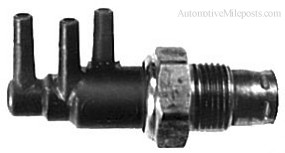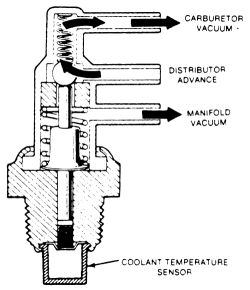72HCODE
"My World is Fire and Blood"
What is it? what does it do? is it an emissions control device?
This is what a Distributor Vacuum Control Valve or Ported Vacuum Switch looks like

This little device may not appear to be all that important in fact most people believe it to be a direct part of the evil emissions system, but it has a big job to do when your engine gets too hot. The threaded end looks a bit like an engine temperature sensor or a thermostat, and that's because it is.
It's normally mounted on the intake manifold or engine block where it can sense coolant temperature. On the 351 Cleveland or 302 there is a port for it right on the water pump housing around the alternator.

The three ports at the other end are for vacuum connections. One goes to full manifold vacuum, another to carburetor vacuum or ported vacuum, and the third goes to the vacuum advance on the distributor.

At normal engine temperatures, the distributor gets ported vacuum, which is 0 psi at idle. During extended idling on a hot day in bumper to bumper traffic, the engine temperature can start to rise pretty fast, especially with air conditioning on. That's when this little device goes to work.
When engine temperatures reach about 225 degrees, this switch changes the distributor vacuum advance source from ported to full manifold vacuum, which is high at idle. This advances the timing and engine rpm increases.
The result is increased radiator fan speed and coolant flow through the engine and radiator, which tends to bring the temperature down.
Once the sensor determines the coolant temperatures have dropped to a safe level, it reverts back to ported vacuum and the engine timing returns to normal, returning the idle rpm to its normal setting.
Chances are most people have never even noticed when this device is protecting their engine, they just notice that the temperature gauge drops a bit, or the HOT light on the instrument panel extinguishes.
This Valve is a compensation to the emission system. It addresses a problem that can occur with lower timing at idle and engine overheating. since all 71-73 cars were designed to use ported manifold vacuum as an emissions reduction at idle if you have an A/C car with heavy load on accessories and you want to maintain stock functions of the engine, its a good idea to restore this valve if it is missing from your vehicle.
Personally i think its pretty trick having the ability to change the type of vacuum the distributor sees at idle based on Engine temperature, even if the trade off is reduced idle emissions, and emissions control is evil.
now at a car show when somebody points to one of these valve and doesn't know what it is or takes out a cross and shoots garlic at it, you can tell them what you learned here .
.
This is what a Distributor Vacuum Control Valve or Ported Vacuum Switch looks like

This little device may not appear to be all that important in fact most people believe it to be a direct part of the evil emissions system, but it has a big job to do when your engine gets too hot. The threaded end looks a bit like an engine temperature sensor or a thermostat, and that's because it is.
It's normally mounted on the intake manifold or engine block where it can sense coolant temperature. On the 351 Cleveland or 302 there is a port for it right on the water pump housing around the alternator.

The three ports at the other end are for vacuum connections. One goes to full manifold vacuum, another to carburetor vacuum or ported vacuum, and the third goes to the vacuum advance on the distributor.

At normal engine temperatures, the distributor gets ported vacuum, which is 0 psi at idle. During extended idling on a hot day in bumper to bumper traffic, the engine temperature can start to rise pretty fast, especially with air conditioning on. That's when this little device goes to work.
When engine temperatures reach about 225 degrees, this switch changes the distributor vacuum advance source from ported to full manifold vacuum, which is high at idle. This advances the timing and engine rpm increases.
The result is increased radiator fan speed and coolant flow through the engine and radiator, which tends to bring the temperature down.
Once the sensor determines the coolant temperatures have dropped to a safe level, it reverts back to ported vacuum and the engine timing returns to normal, returning the idle rpm to its normal setting.
Chances are most people have never even noticed when this device is protecting their engine, they just notice that the temperature gauge drops a bit, or the HOT light on the instrument panel extinguishes.
This Valve is a compensation to the emission system. It addresses a problem that can occur with lower timing at idle and engine overheating. since all 71-73 cars were designed to use ported manifold vacuum as an emissions reduction at idle if you have an A/C car with heavy load on accessories and you want to maintain stock functions of the engine, its a good idea to restore this valve if it is missing from your vehicle.
Personally i think its pretty trick having the ability to change the type of vacuum the distributor sees at idle based on Engine temperature, even if the trade off is reduced idle emissions, and emissions control is evil.
now at a car show when somebody points to one of these valve and doesn't know what it is or takes out a cross and shoots garlic at it, you can tell them what you learned here





















































